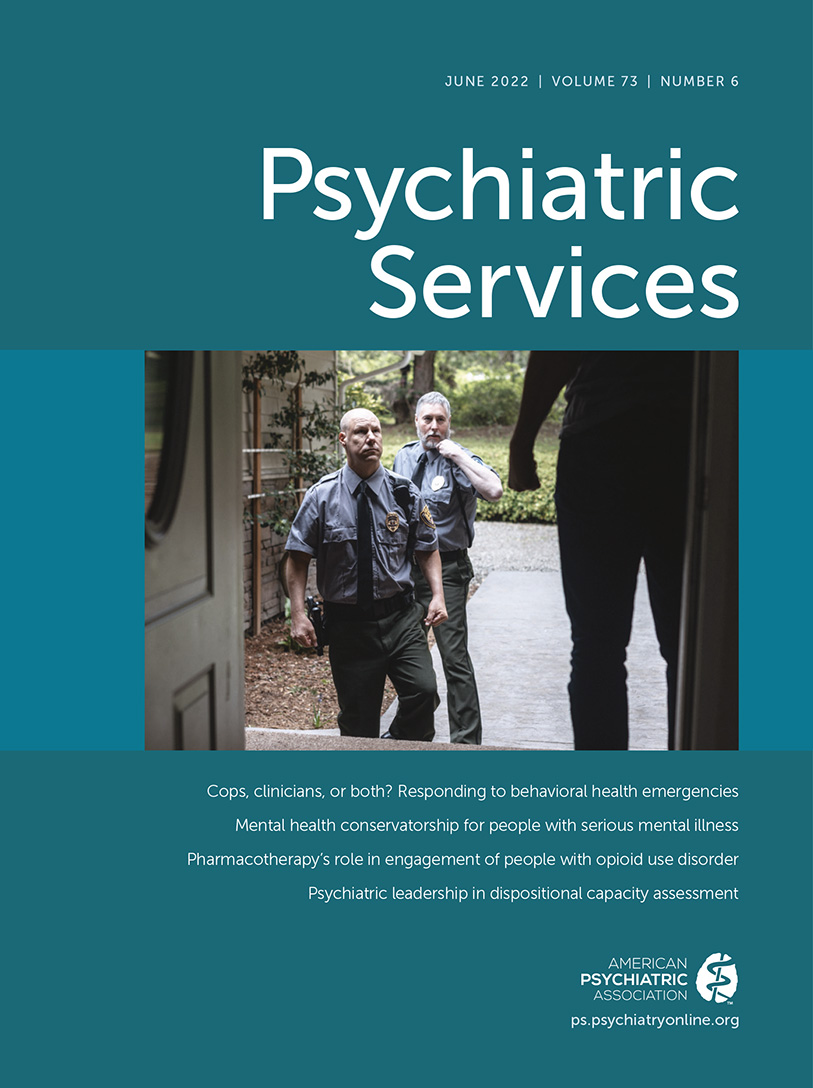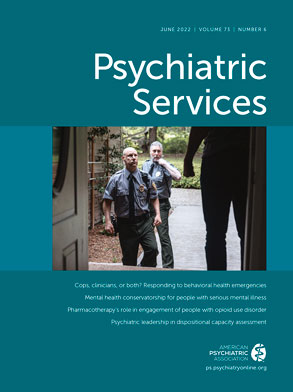The COVID-19 pandemic has caused widespread morbidity, mortality, and marked disruptions in nearly every area of daily life. Social distancing and stay-at-home provisions have required people to limit their in-person interactions. Many patients and providers have been ill or have known someone who died of COVID-19 (
1). Economic distress from job loss, business closures, and growing economic inequality has caused considerable stress (
2).
New York State (NYS) was an early national hot spot for COVID-19. Governor Cuomo declared a state of emergency in response to the virus on March 7, 2020 (
3). The March 22 executive order, “New York State on PAUSE,” closed most nonessential services in NYS; required all nonessential employees to work remotely; and encouraged essential employees, including clinicians, to work remotely to the extent possible (
4). Outpatient providers quickly adapted to deliver more telehealth and fewer in-person services (
5).
Changes in daily life throughout the pandemic, including disruptions in health care service delivery, have posed particular challenges for individuals with mental illness. Certain mental illnesses are associated with an increased risk of COVID-19 exposure, morbidity, and mortality (
6). Research conducted early in the pandemic predicted increases in substance use (
7)—especially alcohol use (
8)—loneliness, isolation, and domestic abuse (
9). People with mental illness are often already economically and socially marginalized and are at disproportionately higher risk for substance use disorders (
10) and suicide (
11). It is critical to understand the particular impact of the COVID-19 pandemic on the health and well-being of individuals with mental illness, how these individuals have coped with stress, and their use of and satisfaction with mental health services.
Previously published research has focused on the mental health impacts of COVID-19 on the general population (
12,
13) and among frontline health workers in particular (
14). Riehm and colleagues (
15) found higher odds of mental distress in the general population in April and May 2020 compared with March 2020, just prior to the pandemic. Within populations with mental illness, much research has been done on experiences with telehealth (
16). A study published early in the pandemic surveyed individuals with mental illness on their anticipated stressors related to the pandemic, finding marked concerns related to the potential worsening of their mental illness, accessing mental health care, and experiencing adverse social determinants of health (
17). The current study aimed to expand the size and scope of this research and investigate the experiences of individuals with mental illness during the pandemic in the first epicenter of COVID-19 in the United States.
To better understand the lived experiences of people early in the pandemic, the NYS Office of Mental Health (OMH) conducted a survey to assess the impact of the COVID-19 pandemic on the lives of OMH service recipients and their family members. OMH sought to determine the extent to which service recipients responded to changes in mode and frequency of service delivery, the impact of the pandemic on various social determinants of health (e.g., food security, financial stability, safe housing) and functional needs (e.g., toiletries and clean clothes), and the sources of support respondents leveraged to cope with the pandemic.
Methods
OMH serves over 700,000 individuals per year across the 23 psychiatric centers it operates and the more than 4,500 locally operated programs it regulates and licenses. The OMH Office of Consumer Affairs, in collaboration with the OMH Institute for Program and Policy Innovation, developed the COVID-19 Impact Survey for Recipients of Services and Families in April 2020 (the survey announcement and instrument are available as an
online supplement to this report) (
18). The survey sampled individuals who obtained mental health services from programs operated, funded, or licensed by OMH. These individuals included children, adolescents, and adults. Respondents were surveyed on topic areas important for identifying actionable input from the population served and their families. These topic areas included the impact of the pandemic on the mental health and well-being of respondents, respondents’ experiences with telehealth, respondents’ access to care and resources, and sources and adequacy of support. Survey items related to demographic characteristics, social determinants of health, and functional needs were based on standardized annual assessments conducted by OMH.
OMH disseminated the survey through consumer advocacy Listservs, trade organizations, peer communities, regional field offices, county mental health authorities, and social media. Responses were collected via the SurveyMonkey platform. Survey data were collected between May 8, 2020, and June 22, 2020. Descriptive statistics on the response data were performed by using SAS, version 9.2. The OMH Institutional Review Board determined that this survey was not human subjects research.
Results
In total, 4,046 recipients of OMH mental health services responded to the survey. Most respondents were female (51%), non-Latinx White (51%), and age 55 or older (37%) (
Table 1). Respondents identified marked impacts of COVID-19 on their personal mental health and well-being: 70% of respondents reported some increase in stress or anxiety, and 21% reported greater alcohol or substance use during the early months of the pandemic. Over half of respondents (55%) experienced at least one COVID-19–related challenge involving adverse social determinants of health and challenges with functional needs, including food insecurity (33%), difficulty accessing transportation (32%), employment barriers (32%), and loss of income or employment benefits (31%). Of those respondents who cited experiencing at least one challenge, 50% (N=1,109) reported experiencing two or more.
Access to personal protective equipment (PPE) and COVID-19 testing were a concern during the early months of the pandemic. Of respondents who reported challenges accessing PPE (32%), more cited limited supplies as the prohibitive factor than those who cited cost. Among those who encountered COVID-19 testing barriers (31%), the most cited barrier was a lack of information regarding testing locations. Access to general medical health care was significantly disrupted for 25% of respondents. While 92% of respondents reported using telehealth, fewer respondents (70% of telehealth users) reported feeling comfortable doing so. Among respondents who reported barriers to using telehealth, 61% reported not being offered telehealth as the main reason.
Despite adverse effects on respondents’ mental health and well-being, as well as considerable disruptions in general medical health care, a large majority of respondents (90%) reported receiving adequate support during the early months of the pandemic. Respondents indicated that a majority of this support came from providers (93%) and family (64%). Just over half of respondents (53%) reported using technology for support. Peers were the least likely to be reported as sources of support (28%).
Discussion
Individuals receiving care in a large public mental health system experienced considerable adverse effects on their mental health and well-being during the spring 2020 COVID-19 surge. These impacts could lead to increased adverse outcomes, including increases in use of acute mental health services as well as self-harm, suicide attempts, deaths by suicide, and accidental overdoses. As communities reopen, more people may be seeking outpatient mental health care, posing challenges for clinics about where to focus their efforts. While evidence from previous crises shows that mental distress decreases as the crisis dissipates, with a majority abating a year after the crisis ended (
19), providers and policy makers should be prepared to monitor these trends and respond as needed.
A substantial number of individuals experienced disrupted access to services and care. This finding is not surprising given the extent of the lockdown implemented to manage the pandemic. Efforts to preserve access to care via telehealth appeared to have a marked impact. A majority of respondents indicated that they did not experience barriers in accessing COVID-19 PPE, testing, or health care services, although approximately one-third of the sample experienced barriers. Notably, a majority of respondents reported experiencing COVID-19–related adverse social determinants of health and functional needs challenges, including food insecurity, lack of access to transportation, employment barriers, and loss of income or employment benefits. This finding is concerning given that this population includes many individuals at high risk for poor health outcomes related to the impacts of these social determinants.
Despite these barriers, respondents overwhelmingly felt supported by both formal and informal supports. Much of the support came from providers and family members, underscoring the critical role of informal support for mental health service recipients. Educational material for friends and family of care recipients could serve as resources about where to access care and how best to support loved ones experiencing mental illness. It is notable that fewer respondents reported peers as a source of support, given how extensive the peer services system is in NYS. This finding should be investigated further.
One potential limitation of these data was that the survey was conducted in the early months of the pandemic, and the experiences of individuals with mental illness have changed as the pandemic has progressed. However, these data provide a window into the early phases of a pandemic that can help to understand its immediate impact. Moreover, the number of respondents captured in the survey makes it one of the largest surveys of a public mental health system since the pandemic began. A second potential limitation was the survey distribution method. Because the survey was primarily distributed online, the survey response rate could not be determined; furthermore, there may have been a selection bias, insofar as respondents with Internet access would have been more likely to have had the means to respond to the survey. That said, substantial efforts were made to reach participants without Internet access: OMH conducted outreach to service providers statewide to encourage providers to complete the survey with their patients. Furthermore, the demographic characteristics of the sample were largely consistent with the characteristics of the population receiving services from the NYS public mental health system. Statewide, 52% of OMH service recipients are female, 51% non-Hispanic White, 25% non-Hispanic Black, 22% Hispanic, and 71% between the ages of 21 and 64. Thus, we are confident that the results presented are representative of the population OMH serves as a whole. Last, in retrospect, it would have been beneficial to ask about respondents’ experiences with race and racism during the COVID-19 pandemic and their interplay with the national reckoning with structural racism. It will be critical to assess experiences with racism moving forward.
These data provide important insights into the experiences of individuals with mental illness and the impact of COVID-19 on this population. Further research will analyze disparities in responses on the basis of demographic characteristics.
Conclusions
This survey, one of the largest conducted to date on this population, demonstrated how individuals with mental illness were affected during the early months of the COVID-19 pandemic. The most evident impacts were the reported increases in anxiety and stress as well as challenges related to adverse social determinants of health and functional needs. Accessing PPE and COVID-19 testing were challenging for many respondents at the beginning of the pandemic. Mental health care continued through telehealth, and most respondents felt comfortable with these services. The vast majority of respondents felt adequately supported during the early months of the pandemic. Moving forward, it will be critical to examine differences in these responses on the basis of demographic characteristics, with a particular focus on possible disparities by race-ethnicity, gender, age, and region.
Acknowledgments
The authors thank Riti Pritam, M.A., M.R.P., and Shuo Chen, M.P.H., for their contributions to the analysis of the survey data. Dr. Lewis-Fernández owns stock in Vistagen Therapeutics.

